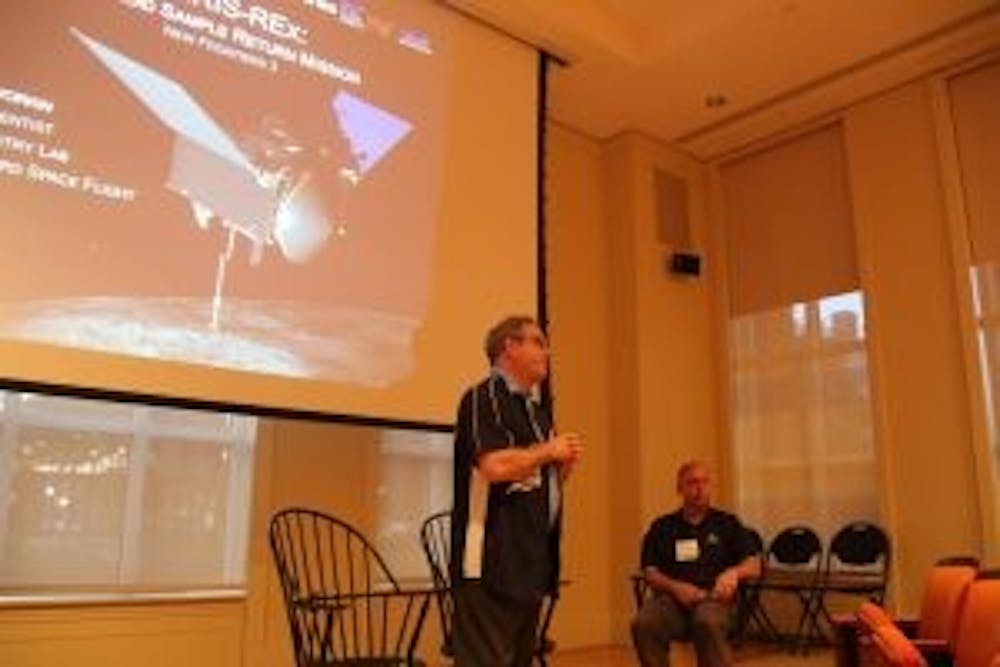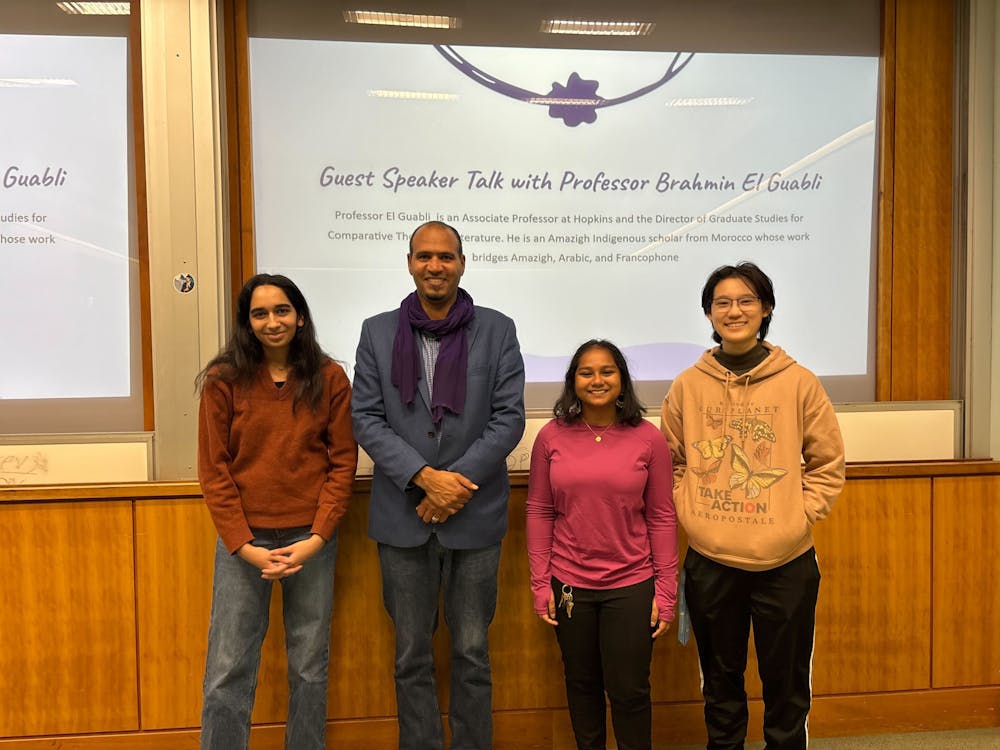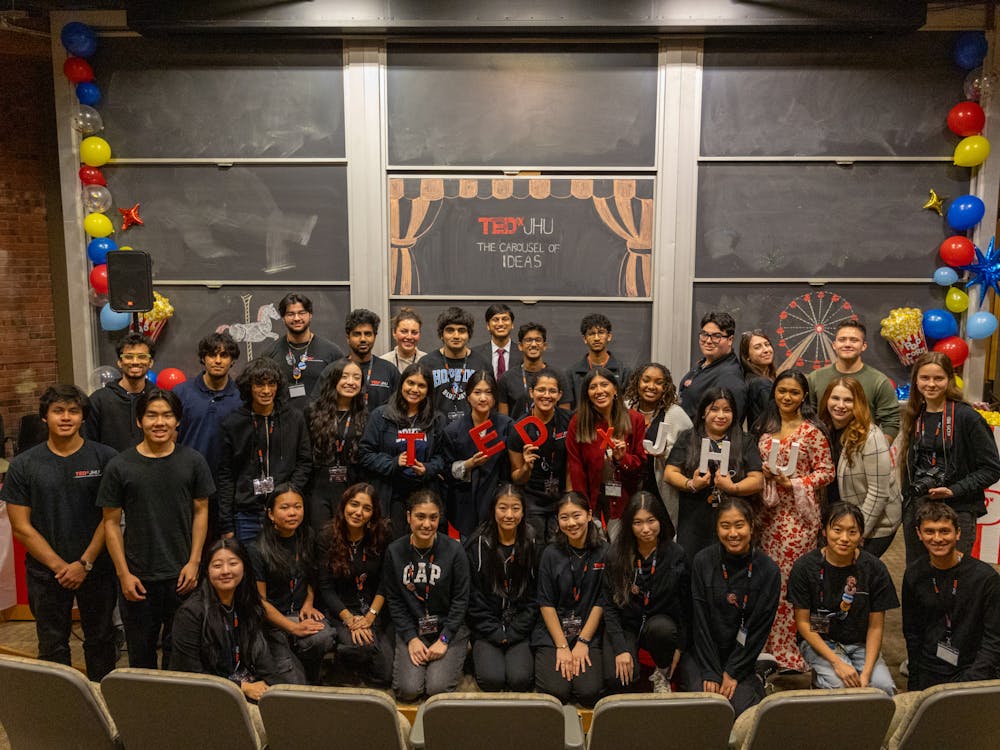Three experts working on OSIRIS-REx, a project to return asteroid samples to Earth, came to Mason Hall on Monday to speak about their mission objectives, the spacecraft’s capabilities and the technical problems they overcame.
The event was organized by the Office of Alumni Relations Aerospace Affinity group, which holds events with aerospace experts.
The three experts were Mission Project Scientist Jason Dworkin, Project Systems Engineer David Everett and Instrument Systems Engineer Michael Pryzby. The audience at the event had a range of prior knowledge and scientific experience, consisting of space experts, scientists and the public.
The OSIRIS-REx spacecraft, launched on Sept. 8, will begin sampling at around July 4, 2020 and the sample collection capsule will return back to Earth on September 24, 2023.
The target of OSIRIS-REx is an asteroid called Bennu. Radar observations show that its diameter is about 500 meters, roughly the size of Homewood campus, has a low rotational velocity and has loose rocks on the surface.
Dworkin explained that scientific interest in asteroids comes from the possibility that they may hold carbonaceous material from Earth. During the formation of the solar system, asteroids and meteorites constantly bombarded the young Earth. This carbonaceous material can give information about early Earth and the appearance of life, since evidence on our planet’s surface has been destroyed by geologic processes.
OSIRIS-REx is designed to collect anywhere from 60 grams to two kilograms of carbon-rich regolith. Although no one is certain that Bennus contains organic compounds from early Earth, Dworkin said the chances are high that it does.
“We have a visible spectrum of the object that is very dark and that fits carbonaceous dark meteorites. We also acknowledge that the telescopes are sampling top few millimeters,” he said. “This is the astronomer’s best guess. It’s a very good guess, but we won’t know until we get the sample back or additional spectral information.”
Dworkin also explained the merits of returning a sample for analysis, rather than performing analysis on the surface, which is what the Mars rovers have done.
“The best part of this in bringing the samples back is that you can ask questions that you have not thought of before. You can design instruments and use them again to interpret your sample from people who weren’t born when the mission was conceived or either sitting in the audience right now with new ideas about how to analyze our sample,” he said. “Because when you design a spacecraft full of fantastic instruments, you’re answering questions you had in mind when you designed the spacecraft.”
But this doesn’t mean OSIRIS-REx won’t try to get all the information about Bennu that it can. As it approaches Bennu, it will collect data from its instruments onboard for albedo and spectral properties, thermal flux, high resolution imaging, surface topography and elemental abundances. It will also measure the gravity field through the relativistic Doppler effect and fluctuation in orbital path and derive Bennu’s internal structure and the surface acceleration.
The probe will also study the Yarkovsky effect, the torque applied on a small astronomical body due to a thermal gradient on the surface caused by uneven solar radiation.
This effect has been proposed as a potential method to deflect asteroids from impacting the Earth by painting the surface of the asteroid to create an uneven solar heat distribution. The asteroid Bennu is listed as a potential Earth impactor, thus making the study especially relevant.
Dworkin further explained what separates OSIRIS-REx from other space missions aimed to bring back samples to Earth.
“The Apollo missions were the first space missions that used sample return to discover facts of scientific interest. The unmanned Luna missions of the Soviet Union returned samples from the moon as well,” Dworkin said. “NASA has performed two other sample return missions, Genesis and Stardust, to collect particles from the solar wind and a comet, but OSIRIS-REx will be NASA’s first sample return from an asteroid.”
Analysis of moon rocks led to the giant-impact hypothesis, which posits that the moon was formed from the same material as Earth through a collision with another astronomical body.
“It allowed us to age date the moon for the first time and see that the moon crust is similar to the earth’s crust. This would not have been known by telescopic observations,” he said.
Everett, the systems engineer, noted that unlike missions to Mars that performed a flyby, orbit, mapping and landing phases separately, OSIRIS-REx will do it all at once, capping it off with an autonomous landing known as the touch and go (TAG) maneuver. It will arrive in orbit on August 18, 2018 and conduct two orbital phases.
“Orbit A is a higher orbit. We go from navigating by radio link and star fields to navigation based on the ground survey,” Everett said. “Orbit B is a lower orbit. We will orbit around 1000 meters from the center. It takes 24 hours to orbit once around because the gravity is so low. Orbit B is where we’ll do more detailed looks at our target sites. Once we decide one of three TAG sites, we’ll do detailed reconnaissance to where we fly in within 250 meters of the surface and get less than one centimeter resolution imagery. Then we do a couple of rehearsals where we go all the way down just short (25 meters) of touching the surface.”
He described TAG as the hardest part of the mission due to Bennu’s extremely weak gravity. They will have to plan deorbit so that the spacecraft lands in a space of about 25 square meters.
“The force of the sunlight shining of sunlight is 10 percent of the force of gravity. It’s a force we had to worry about when we designed the orbit. We’re in this orbit perpendicular to the sunlight and then we’ll do a deorbit burn at nine centimeter per second of change in velocity, and then we trek across 3.6 hours before we cross the LIDAR range threshold,” he said. “We program it ahead of time for 10 centimeters per second, and the spacecraft comes up with 9.9, 10.1, but even little bit of difference makes the trajectory very different. We have to update where we are as we travel.”
During the talk, the speakers also brought the audience outside Mason Hall to view a rocket launch of an International Space Station resupply mission that took off from Wallops Island in Virginia at 7:45 p.m.
The orange speck of the Orbital ATK Antares rocket appeared in the southeastern sky over Baltimore about 90 seconds later and continued to rise for a few minutes before the boosters turned off. The launch was notable because it was the first launch for the private company in two years since an explosion occurred on a resupply mission two years ago.
Hopkins graduate of the Class of ‘97 and ‘02, Michael Makfinsky enjoyed the expertise of the speakers.
“The Aerospace Affinity group is probably one of the better [groups] because they bring the technical experts right out of Goddard. This program is fascinating because it describes the project from the beginning to what the final goal is. So it does help you take an intellectual leap into what NASA is currently engaged in,” he said.
Senior Tarini Konchady liked the insight the speakers gave on the large amount of work and planning that went into OSIRIS-REx.
“They really got across the point that going to space is hard, technically challenging and full of uncertainties,” she said.
Senior Lauren Aldoroty was eager for a successful return of OSIRIS-REx
“I’m really excited that there’s a mission that’s going to return,” she said. “That’s really hard to do.”





